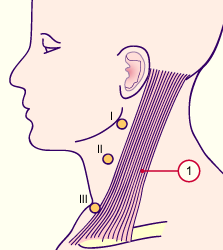|

|
|
|
|
In the region of the headgut, mainly abnormalities associated with the pharyngeal arches, clefts and pouches stand in the foreground. Due to the complexity of the form changes in this region there is a large number of abnormalities that cannot be treated in detail here. Connected with the pharyngeal arches are hypoplasias primarily in the region of the first mandibular arch. Cysts and fistulas result from persisting pharyngeal pouches (among others). Ectopic glandular tissue of the thyroid, of the thymus or the parathyroids can be explained by remaining tissue residuals along their descent. Abnormalities can also result, though, from disorders of the migration or development of neural crest tissue in this region.
|
|
|
|
Cervical fistulas, cysts and sinus
|
|
|
This group of abnormalities can be directly derived from persisting pharyngeal pouches or longitudinal cervical grooves.
Cysts are closed cavities with an epithelial lining.
Sinuses are cavities that remain open towards the outside or towards the pharynx and fistulas are connections between the pharynx and outer surface of the neck. |
|
Fig. 43 - Frequent locations ofcervical cysts, fistulas and sinuses |
|
Legend |
|

1
|
Sternocleidomastoid muscle |
|
|
|
Fig. 43
Frequent locations for lateral cervical cysts, sinuses and fistulas.
The roman numbers indicate the corresponding pharyngeal groove.
|
|
Pierre Robin syndrome (PRS)
|
|
|
|
This abnormality usually combines extreme micrognathia, cleft palate and abnormalities of the ears. Often a relative macroglossia (in relation to a very small lower jaw) is present, which can lead to air passage constrictions because the tongue has the tendency to fall backwards into the throat.
|
|
|
More info
|
|
Most of the time, a PRS does not occur in isolation but is associated with other abnormalities. The short description of syndromes indicates a wide range of additional abnormalities.
|
|
|
|
Persisting thyreoglossal duct
|
|
|
| During the descent of the thyroid gland many problems can occur. Ectopic thyroid tissue can be found along the whole way from the foramen cecum to the isthmus of the normal thyroid below the larynx. |
|
Fig. 44 - Frequent locations of
thyroid tissue remnants |
|
Legend |
|

1
2
3
4
5
6
7
|
Tongue
Foramen cecum
Epiglottis
Hyoid cartilage
Thyroid cartilage
Thyroid gland
Thyreoglossal duct |
|
|
|
Fig. 44
Remnants of thyroid tissue can occur along the entire trajectory of the thyreoglossal duct.
|
|
The CATCH 22 syndrome is a developmental defect of the 3rd and 4th pharyngeal pouches. The symptoms that result from the disordered development of these embryonic structures are hypo- or aplasia of the thymus with defective T-cells and weak immunity. Hypoplasia of the parathyroid with hypocalcaemia and tetanic cramps, cardiac defects (predominately conotruncal defects) and characteristic facial dysmorphisms (hypertelorism; short lid axes; epicanthus; wide, short nose with everted nasal base levels; short philtrum; small, pointed mouth; microretrogenia; low-placed, dysmorphic ears with enlarged anteroposterior diameter). The CATCH 22 syndrome is a clinical picture with a large phenotypic variability in which milder course forms with only partial and/or transient immunity weakness can be encountered besides the frequently lethal full picture of the disease with defective T-cell immunity and cardiac defects. Phenotype overlaps exist with the velocardiofacial syndrome for which the same mutation is responsible.
|
|
|
|
Missing descent of the pharyngeal pouch derivates
|
|
|
|
Parathyroid and thymus complete a considerable migration during their development and therefore tissue remnants can also remain and survive at ectopic locations. . Typically, these tissue remnants do not give rise to functional disorders.
|
|
|
|
|

